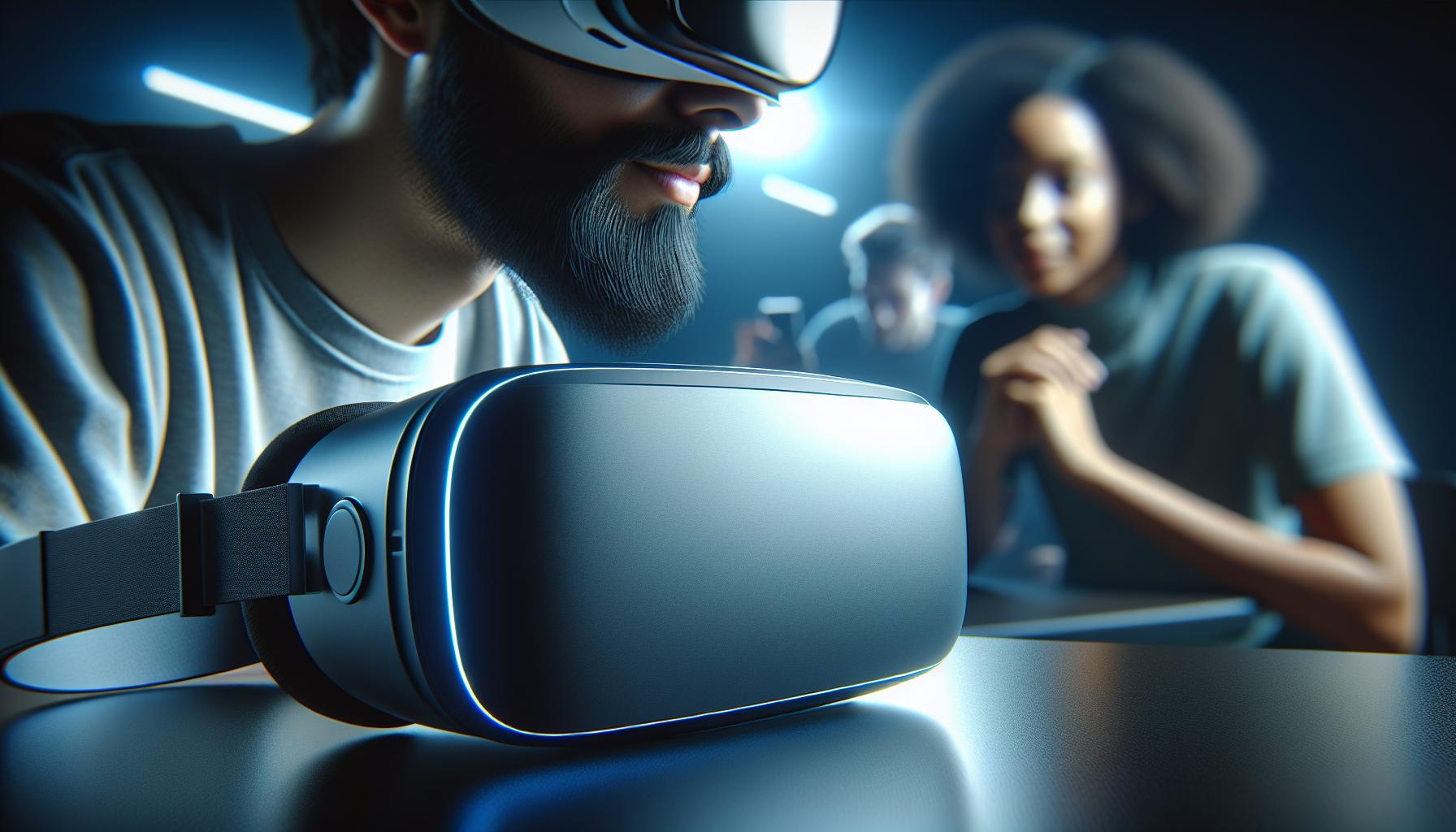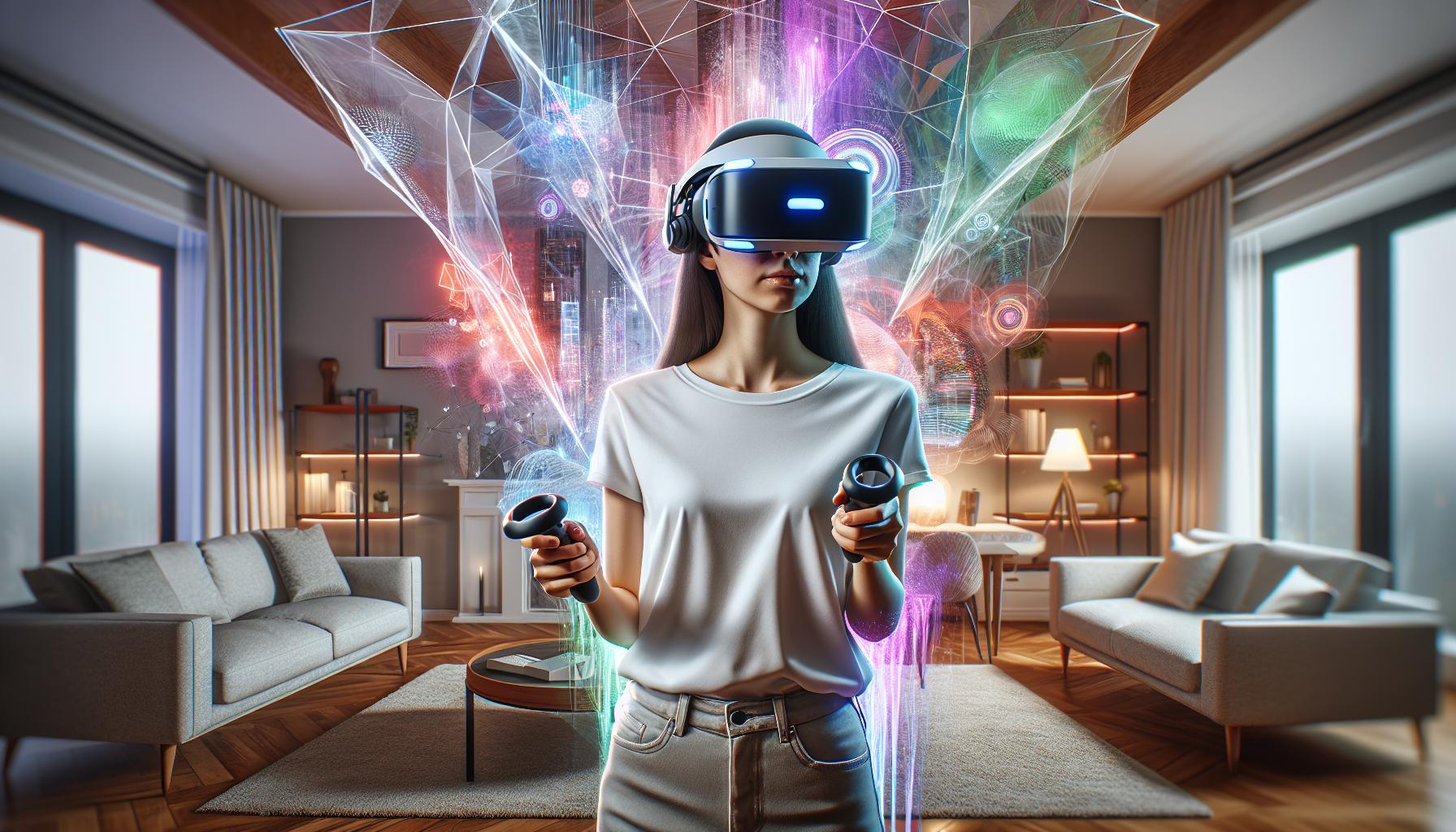Key Takeaways
- Definition of Virtual Reality: Virtual reality (VR) is a technology that simulates immersive digital environments, allowing users to interact with virtual worlds through specialized hardware like VR headsets and motion controllers.
- Applications Across Industries: VR has diverse applications, particularly in education, healthcare, and entertainment, enhancing learning experiences, training simulations, and providing immersive gaming environments.
- Historical Background: The development of VR includes significant milestones from the 1950s to the present, with advancements in technology making VR more accessible and practical for everyday use.
- Core Components: Key components of VR systems include high-resolution headsets, motion controllers, tracking sensors, and advanced audio systems, all of which work together to create a believable experience.
- Benefits of VR: VR offers numerous advantages, such as enhanced immersion, improved learning outcomes, safe training environments, and therapeutic applications, promoting engagement and skill retention.
- Challenges to Consider: Despite its benefits, VR faces challenges like cost barriers, motion sickness, potential social isolation, and health concerns, which can affect user experience and widespread adoption.
Virtual reality has transformed the way people experience digital environments, immersing them in lifelike simulations that feel strikingly real. By using specialized hardware like VR headsets and motion controllers, users can explore virtual worlds, interact with digital objects, and engage in experiences that go beyond traditional gaming or media consumption.
As technology advances, virtual reality is finding applications in various fields, from education and training to healthcare and entertainment. This innovative medium not only entertains but also opens up new possibilities for learning and creativity, making it a fascinating topic for anyone curious about the future of human-computer interaction. Understanding what virtual reality is can unlock a world of opportunities and insights into how it’s shaping our lives.
What Is Virtual Reality?
Virtual reality (VR) creates a simulated environment that users can interact with, often through specialized equipment. VR technology typically includes headsets, motion controllers, and sometimes haptic feedback devices. These tools work together to establish an immersive experience, allowing users to feel as though they are physically present in a virtual world.
Variants of VR include fully immersive systems, which utilize 3D graphics and real-time interactions, and non-immersive VR, where users engage with a 3D environment on a screen. Mixed reality (MR) blends elements of both augmented reality (AR) and VR, providing a comprehensive experience where digital objects coexist with the real world.
Applications of VR span various fields. In education, VR facilitates interactive learning through realistic simulations. In healthcare, it aids in training medical professionals and offering therapeutic experiences for patients. The entertainment industry increasingly adopts VR to enhance gaming experiences and create captivating virtual concerts.
Understanding VR’s functioning and applications enhances insight into its impact on human-computer interaction, creativity, and how individuals engage with digital content.
History Of Virtual Reality

Virtual reality (VR) has a rich history marked by key innovations and developments that have shaped its evolution. From early concepts to contemporary applications, VR’s journey showcases significant milestones in technology and creativity.
Early Innovations
1950s marked the inception of VR concepts. Morton Heilig created the Sensorama, a multi-sensory simulator that provided users with immersive experiences through film, sound, vibration, and smell. In 1968, Ivan Sutherland developed the first head-mounted display (HMD), known as the “Sword of Damocles,” which laid the groundwork for future VR systems. This device utilized rudimentary graphics but offered a glimpse into immersive environments.
Key Developments
1970s and 1980s saw advancements in VR technology. Jaron Lanier founded VPL Research, introducing data gloves and immersive environments where users could interact with virtual worlds. The 1990s brought a surge of interest in VR with products like Sega’s Virtual Fighter and Nintendo’s Virtual Boy; however, limitations in graphics and processing power hindered widespread adoption.
2000s transitioned into more practical applications for VR, especially in training simulations for military and medical fields. The 2010s heralded a renaissance in VR due to affordable technology and the arrival of consumer-grade devices like the Oculus Rift and HTC Vive, making immersive experiences accessible to the public.
Today, VR continues to evolve, supported by advancements in hardware, software, and applications across multiple domains, reflecting its transformative impact on technology and user interaction.
How Virtual Reality Works

Virtual reality (VR) operates by creating immersive environments that users can interact with. This technology relies on several key components and advanced technologies to deliver a believable experience.
Components Of VR Systems
- VR Headsets: VR headsets feature high-resolution displays and lenses, delivering a wide field of view for immersive experiences. They use sensors to track head movements, allowing users to look around a virtual world naturally.
- Motion Controllers: Motion controllers track hand and body movement, enabling natural interactions within virtual environments. They often include buttons and triggers for executing commands or manipulating virtual objects.
- Tracking Sensors: External tracking sensors, whether placed in a room or included within the headset, monitor the user’s position in real-time. This spatial tracking enhances immersion by allowing users to move and interact freely.
- Audio Systems: High-quality spatial audio systems produce realistic soundscapes. Surround sound provides cues about direction and distance, enriching the immersion and making the experience more engaging.
- Computational Hardware: Powerful computers or gaming consoles process the graphical and physical simulations needed for VR. These systems require substantial processing power to render lifelike scenarios in real-time.
- 3D Graphics: Advanced 3D graphics create realistic environments and characters. Techniques like texture mapping and lighting effects enhance depth and realism in VR experiences.
- Haptic Feedback: Haptic devices deliver tactile sensations, allowing users to feel the virtual environment. This technology simulates touch, making interactions more convincing.
- Eye Tracking: Eye tracking technology adjusts the VR experience based on where a user looks. This feature improves rendering efficiency and can enhance interactive storytelling.
- Leap Motion: Leap Motion technology uses cameras to track hand movements. It enables users to interact more intuitively without handheld controllers, enhancing user engagement.
- Artificial Intelligence (AI): AI enhances interactions within VR environments, creating responsive characters and dynamic scenarios. This technology personalizes experiences and allows for unpredictable outcomes, enhancing engagement.
Applications Of Virtual Reality

Virtual reality (VR) plays a crucial role in various sectors, enhancing experiences and providing new opportunities for interaction and learning. Major applications include entertainment and gaming, education and training, as well as healthcare and therapy.
Entertainment And Gaming
Entertainment and gaming significantly benefit from VR technology. Users experience immersive environments that enhance engagement and realism. Popular VR games, such as Beat Saber and Half-Life: Alyx, provide interactive gameplay that directly involves users’ movements and decisions. Virtual concerts and events also offer unique experiences, allowing participants to connect in real-time regardless of their physical location. The entertainment industry continues to explore VR to create compelling narratives that captivate audiences.
Education And Training
Education and training leverage VR to create interactive learning environments. Students explore virtual classrooms where they engage with content actively. For instance, VR simulations allow medical students to practice surgical procedures in a risk-free setting. Companies utilize VR for employee training, providing realistic scenarios that improve skills and retention. Educational institutions have adopted VR field trips, letting students visit historical sites or distant locations without leaving the classroom. These applications promote engagement and enhance understanding.
Healthcare And Therapy
Healthcare and therapy utilize VR for treatment and training purposes. VR simulations offer medical professionals realistic scenarios for practicing surgeries and procedures. This technology aids in pain management by distracting patients during procedures or rehabilitation exercises. Mental health treatment also benefits, with VR assisting in exposure therapy for anxiety and phobias. Studies show that VR significantly reduces stress and improves outcomes in therapeutic settings. The healthcare sector continues to explore innovative uses of VR to enhance patient care and training.
Benefits And Challenges Of Virtual Reality
Virtual reality (VR) presents numerous advantages along with some challenges that stakeholders must consider.
Advantages Of Using VR
- Enhanced Immersion: VR creates lifelike environments, immersing users fully in experiences. Immersive simulations boost engagement in gaming, training, and educational scenarios.
- Improved Learning Outcomes: VR facilitates active participation in learning. Studies show that students retain 90% of information learned through experiences, compared to traditional methods.
- Safe Training Environments: VR offers risk-free settings for training in high-stakes professions like medicine and aviation. Users can practice procedures or emergency responses without real-world consequences.
- Therapeutic Applications: VR serves as a tool in mental health therapy. Exposure therapy through VR helps individuals confront fears in controlled environments, easing anxiety and phobias.
- Increased Accessibility: VR breaks geographical barriers for remote participants. Virtual meetings, simulations, and events enable collaboration, bringing people together regardless of location.
- Cost Barriers: High-quality VR systems require significant investment. Specialized hardware and software often deter widespread adoption among casual users and smaller institutions.
- Motion Sickness: Some users experience nausea or discomfort during prolonged VR sessions. Motion sickness results from discrepancies between visual movement and physical sensation.
- Social Isolation Risks: Extensive VR use may lead to disconnection from real-life interactions. Users might prioritize virtual experiences over face-to-face engagement.
- Health Concerns: Extended VR sessions can strain the eyes and cause discomfort. Eye fatigue and headaches may arise due to prolonged use without breaks.
- Limitations in Content: While VR technology evolves, content availability remains a challenge. High-quality, diverse experiences are still developing, which may limit user engagement.
Forefront of Technological Innovation
Virtual reality stands at the forefront of technological innovation with its ability to create immersive experiences that transform how people interact with digital content. Its applications span across various sectors from education to healthcare and entertainment, showcasing its versatility and potential to enhance learning and creativity. As VR continues to evolve with advancements in hardware and software, it opens up new avenues for engagement and interaction. While challenges remain, the ongoing development of VR technology promises to reshape how individuals experience and connect with the world around them. Embracing this technology could lead to groundbreaking changes in personal and professional realms.